Climate Change Induced Precipitation Effects on Water Resources in the Peace Region of British Columbia, Canada
Abstract
:1. Introduction
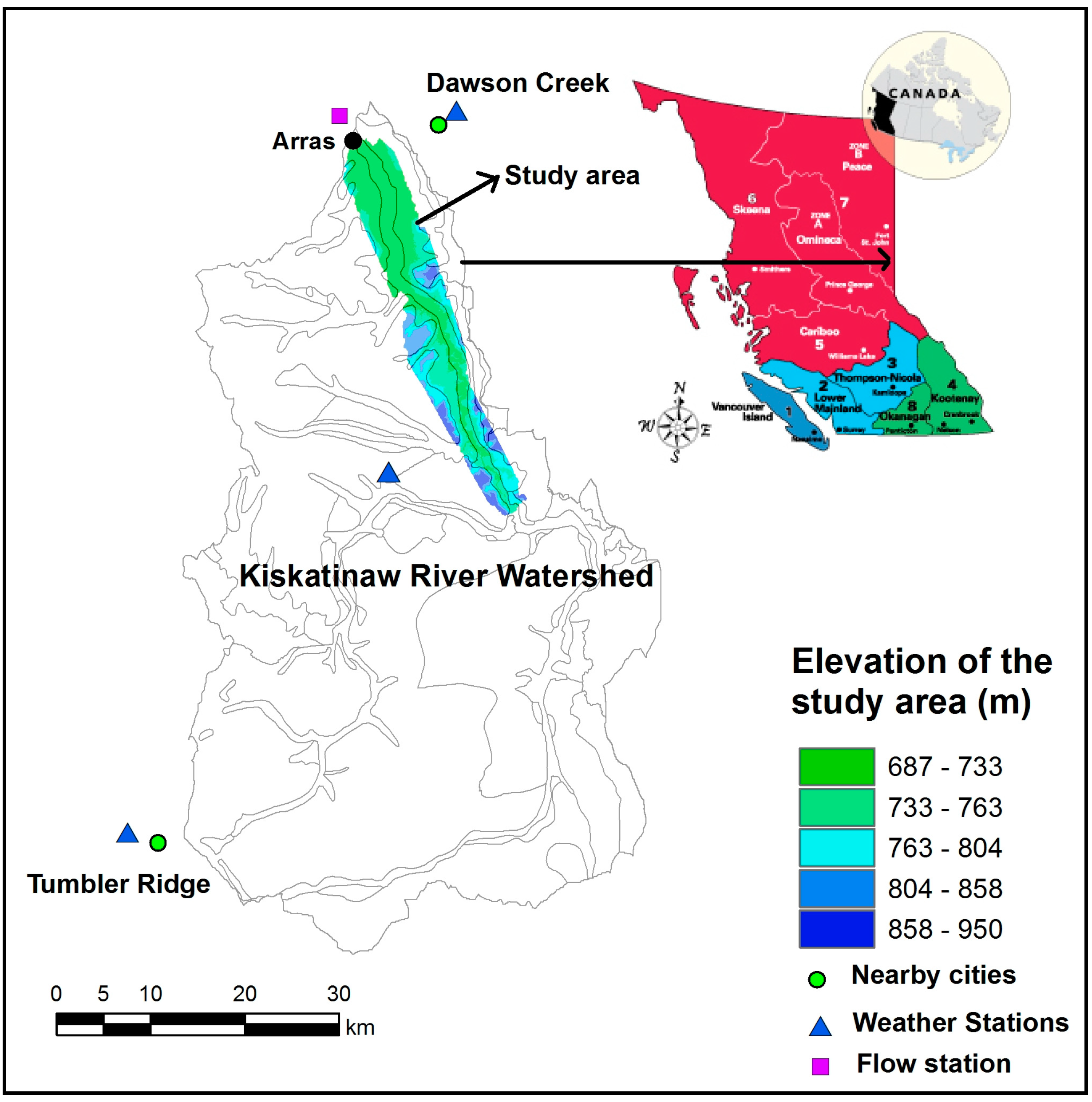
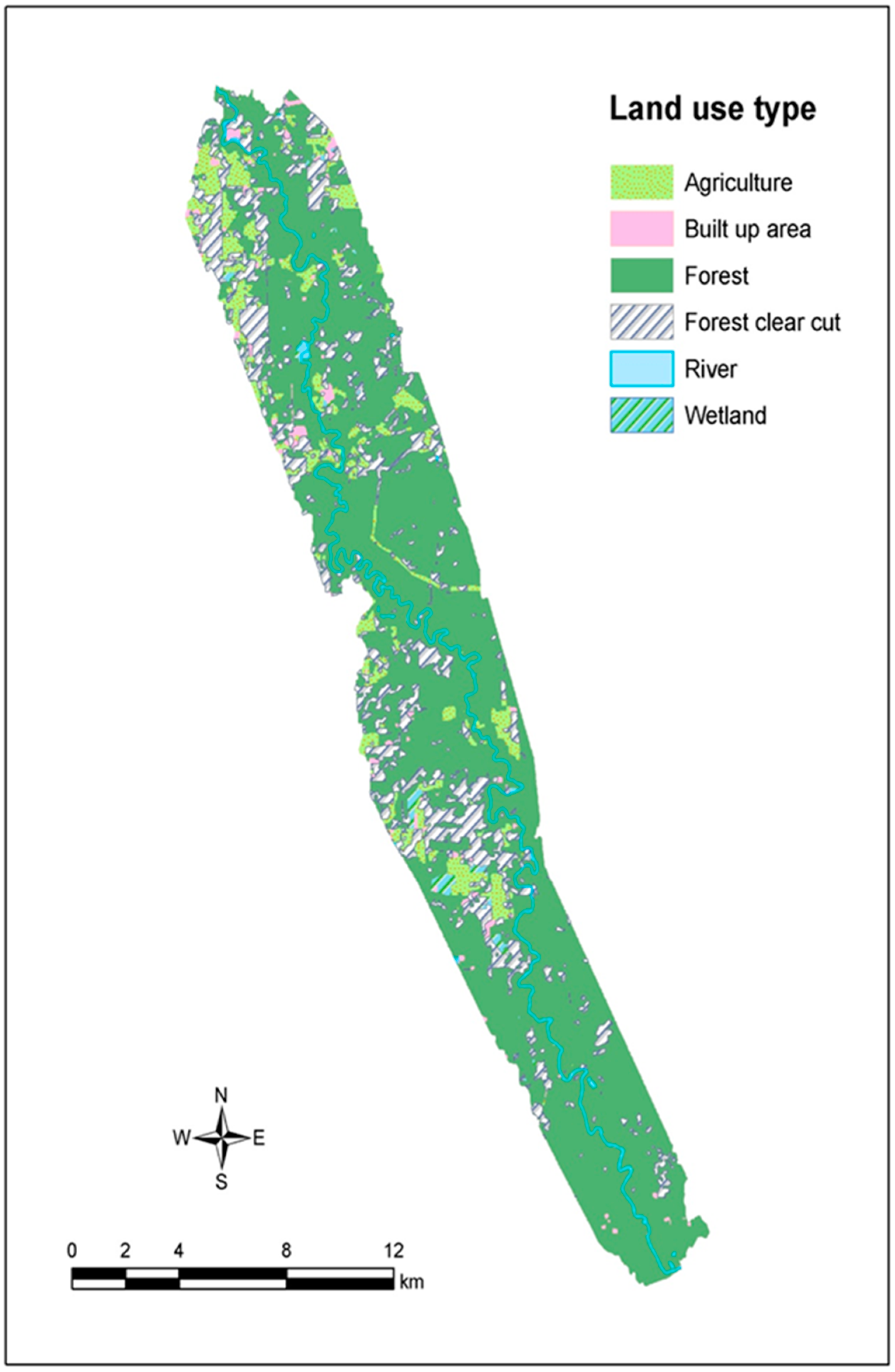
2. Details of Study Area
3. Materials and Methodology
3.1. Data Collection
3.2. GSSHA Hydrological Model Development
- Watershed specific data (e.g., elevation, channel geometry, soil type, land use/land cover), which were obtained from Geographic Information Systems (GIS) databases, satellite images, soil survey reports, and field observations.
- Precipitation and temperature data, and other meteorological data (e.g., barometric pressure, relative humidity, wind speed, direct and global radiation), which were collected from available weather stations in the KRW.
- Stream flow data, which was collected from the nearby Water Survey of Canada station.
- Groundwater level data which were collected from groundwater monitoring network in the KRW.
- Channel cross section data which was approximated based on field survey data.
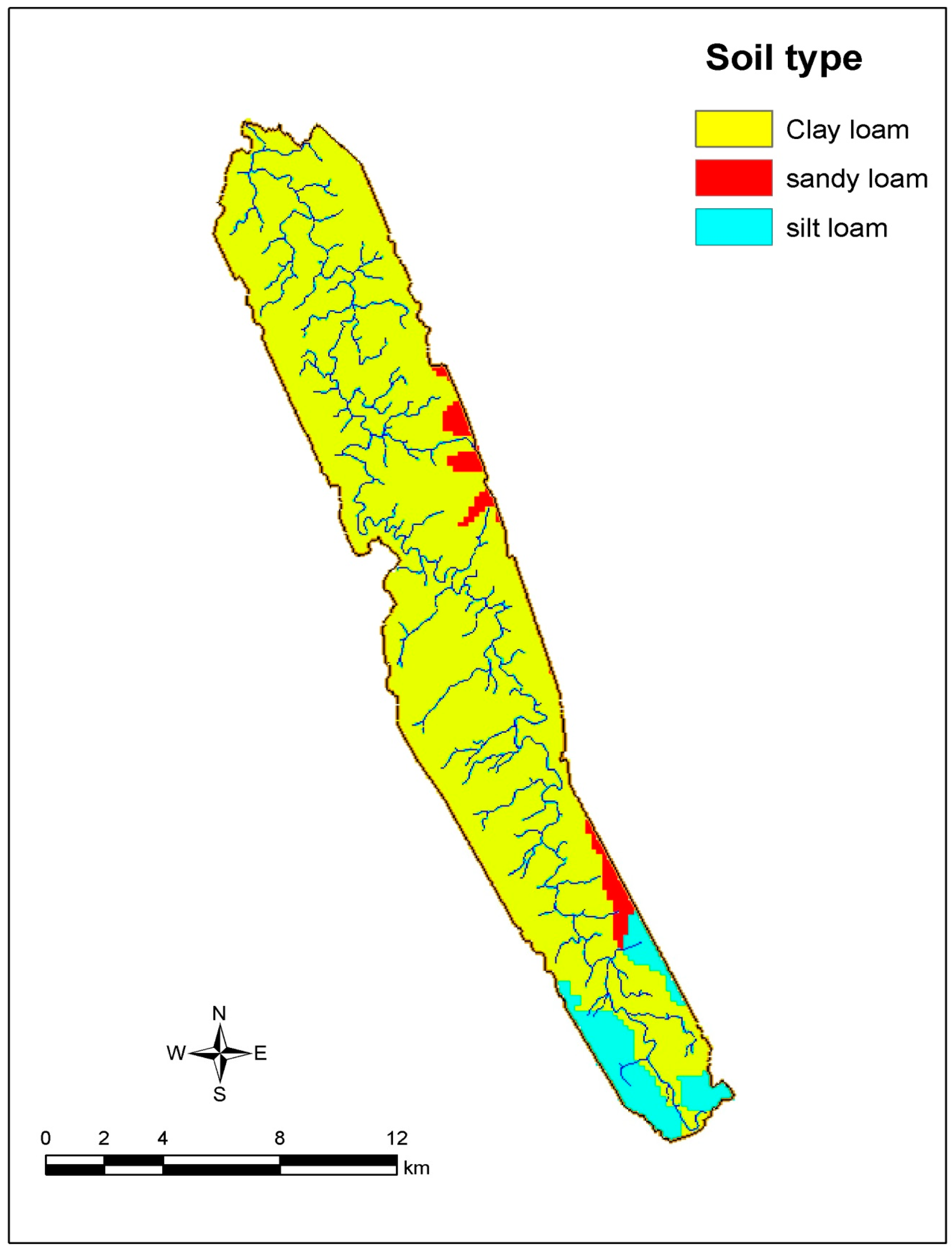
3.3. Model Calibration and Validation
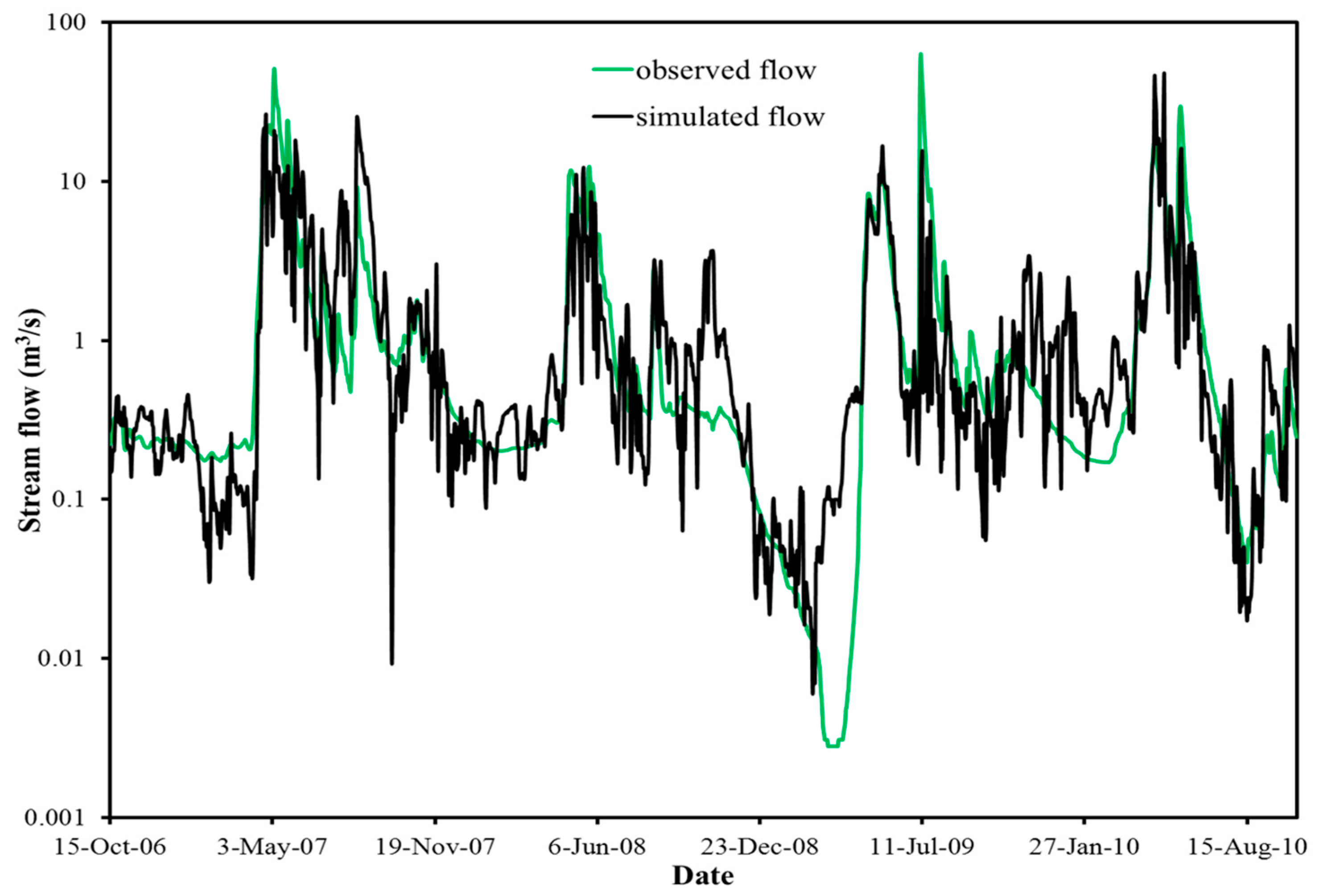
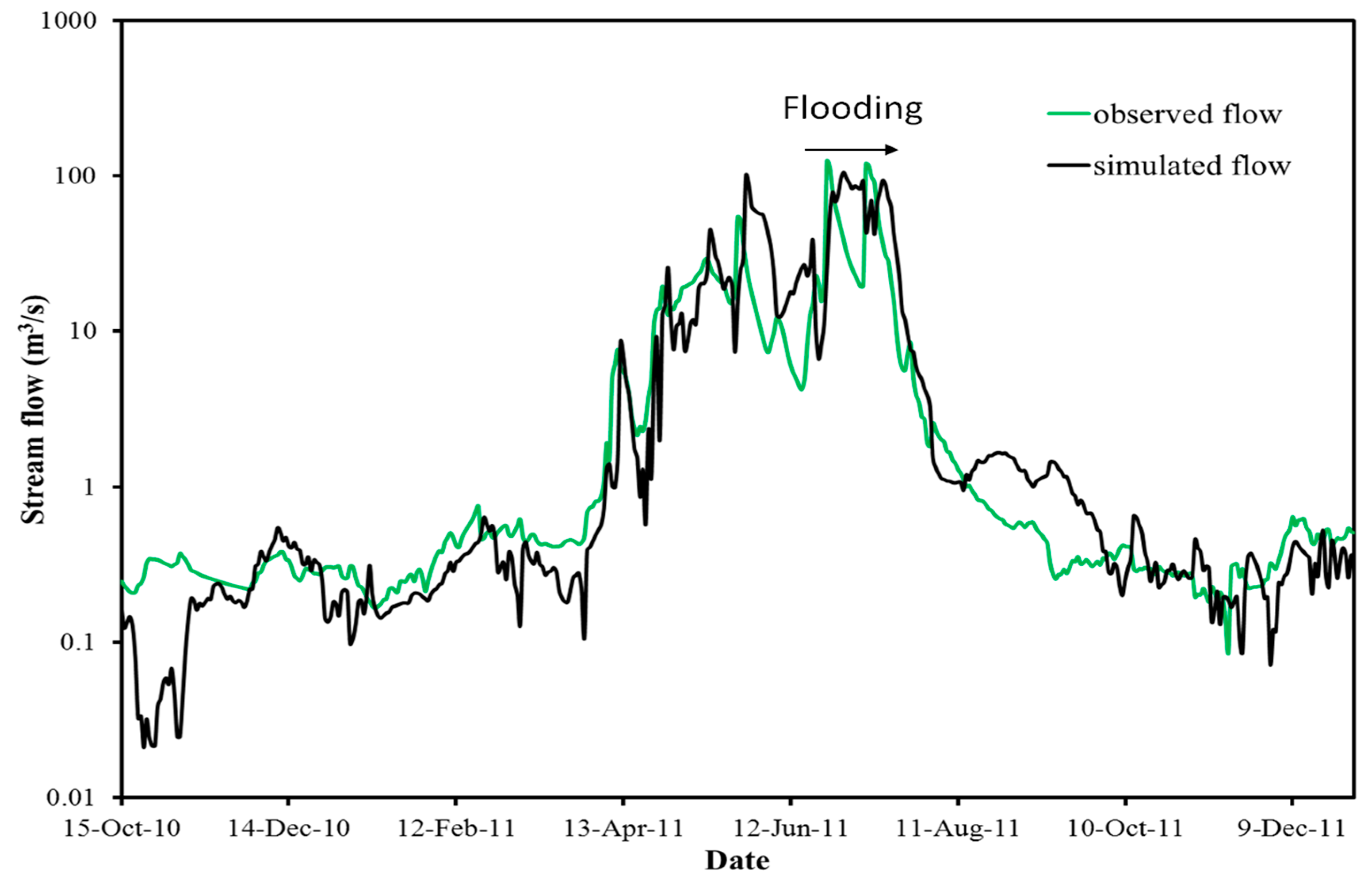
3.4. Generation of Future Climate Scenarios
3.5. Estimation of Groundwater Discharge and Surface Runoff
4. Results and Discussions
4.1. Results of Climate Change
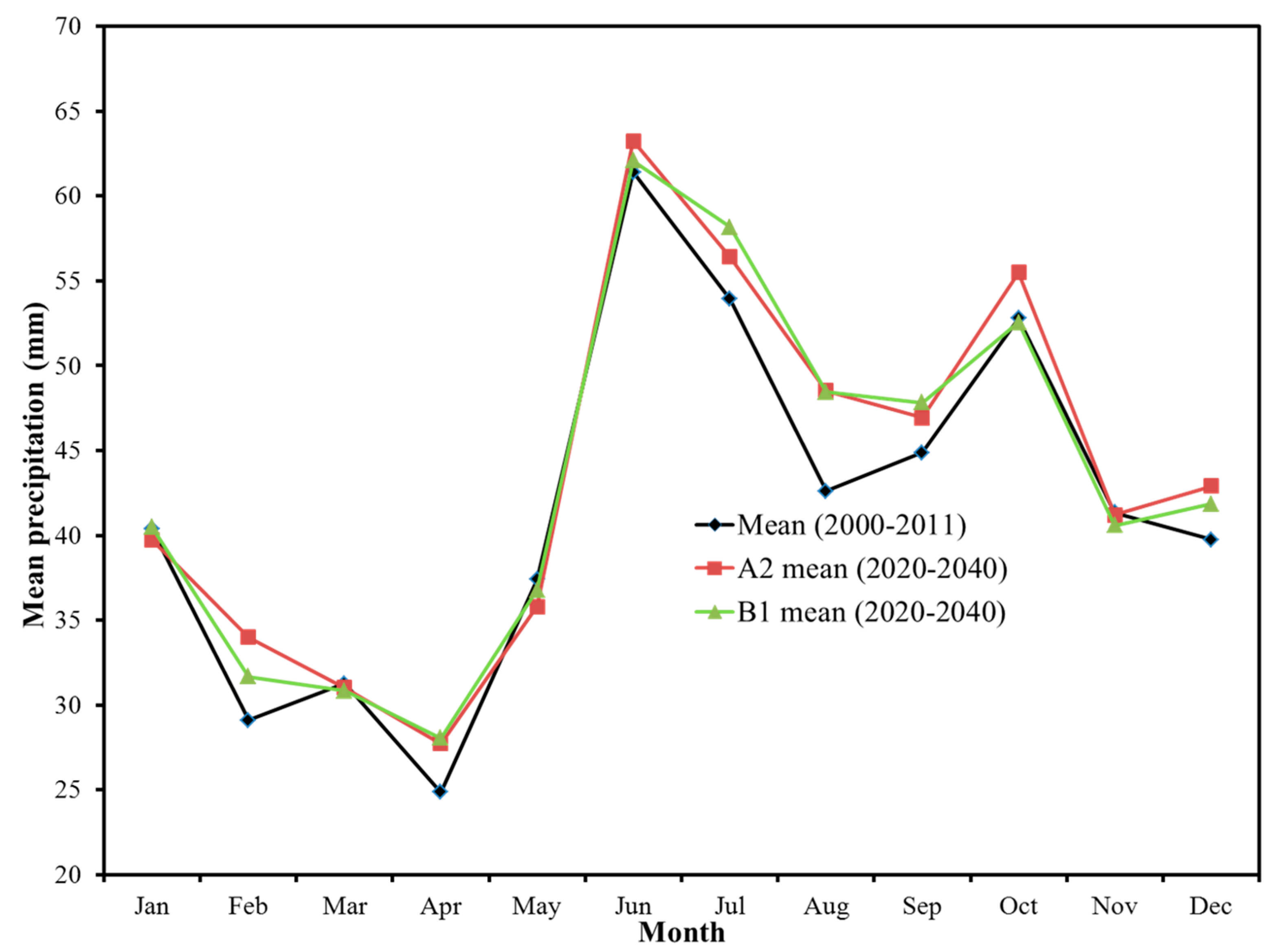
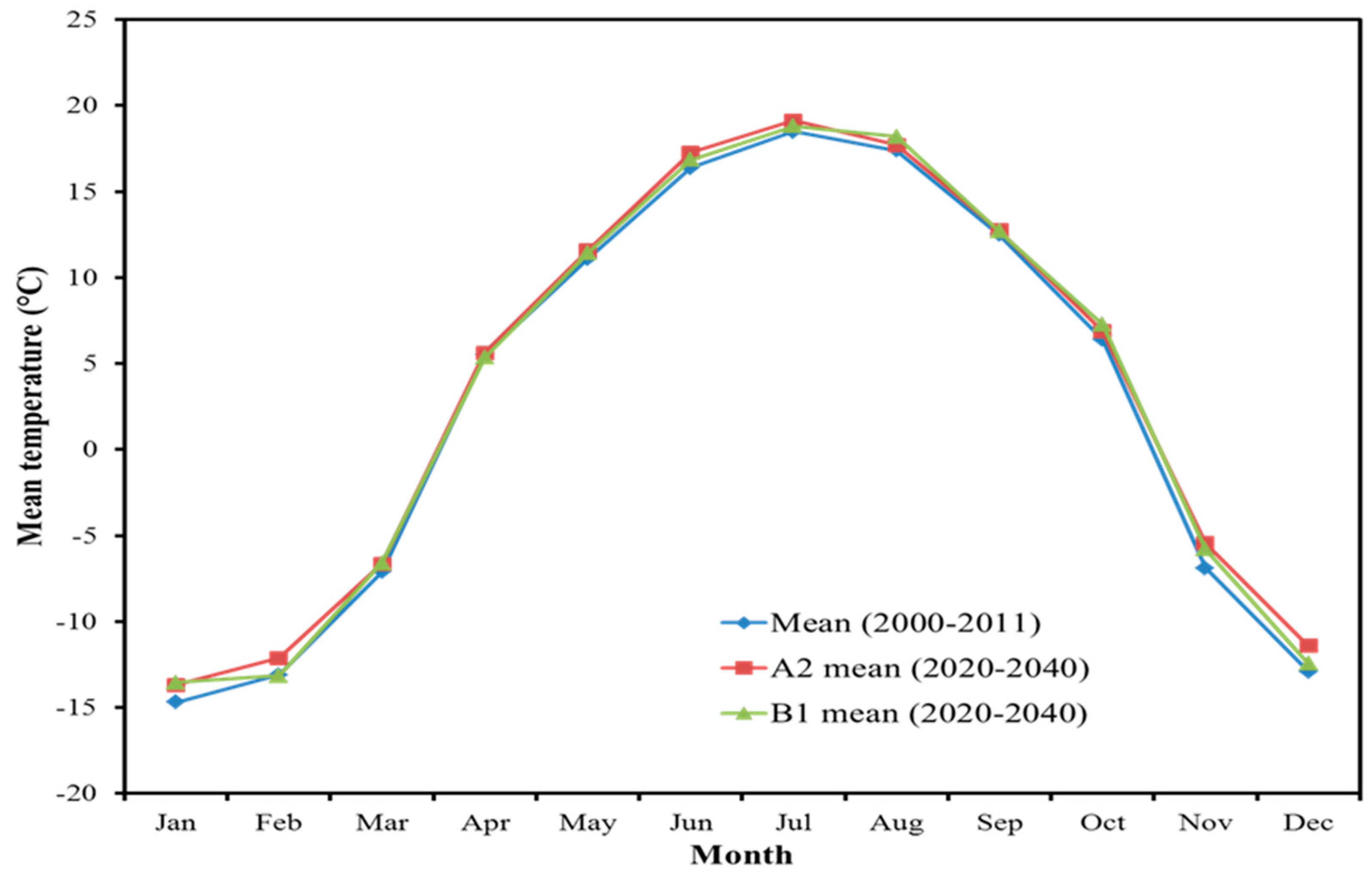
| Scenario | Winter | Spring | Summer | Fall |
|---|---|---|---|---|
| Reference | 109 | 93 | 158 | 138 |
| A2 | 112 | 95 | 173 | 145 |
| (12) | (11) | (17) | (9) | |
| B1 | 114 | 96 | 165 | 141 |
| (13) | (9) | (18) | (13) |
| Scenario | Winter | Spring | Summer | Fall |
|---|---|---|---|---|
| A2 | 3 mm | 2 mm | 15 mm | 7 mm |
| (3%) | (2%) | (9.5%) | (5%) | |
| B1 | 5 mm | 3 mm | 7 mm | 3 mm |
| (4.5%) | (3%) | (4.5%) | (2%) |
4.2. Results of Climate Change Effects on Water Resources
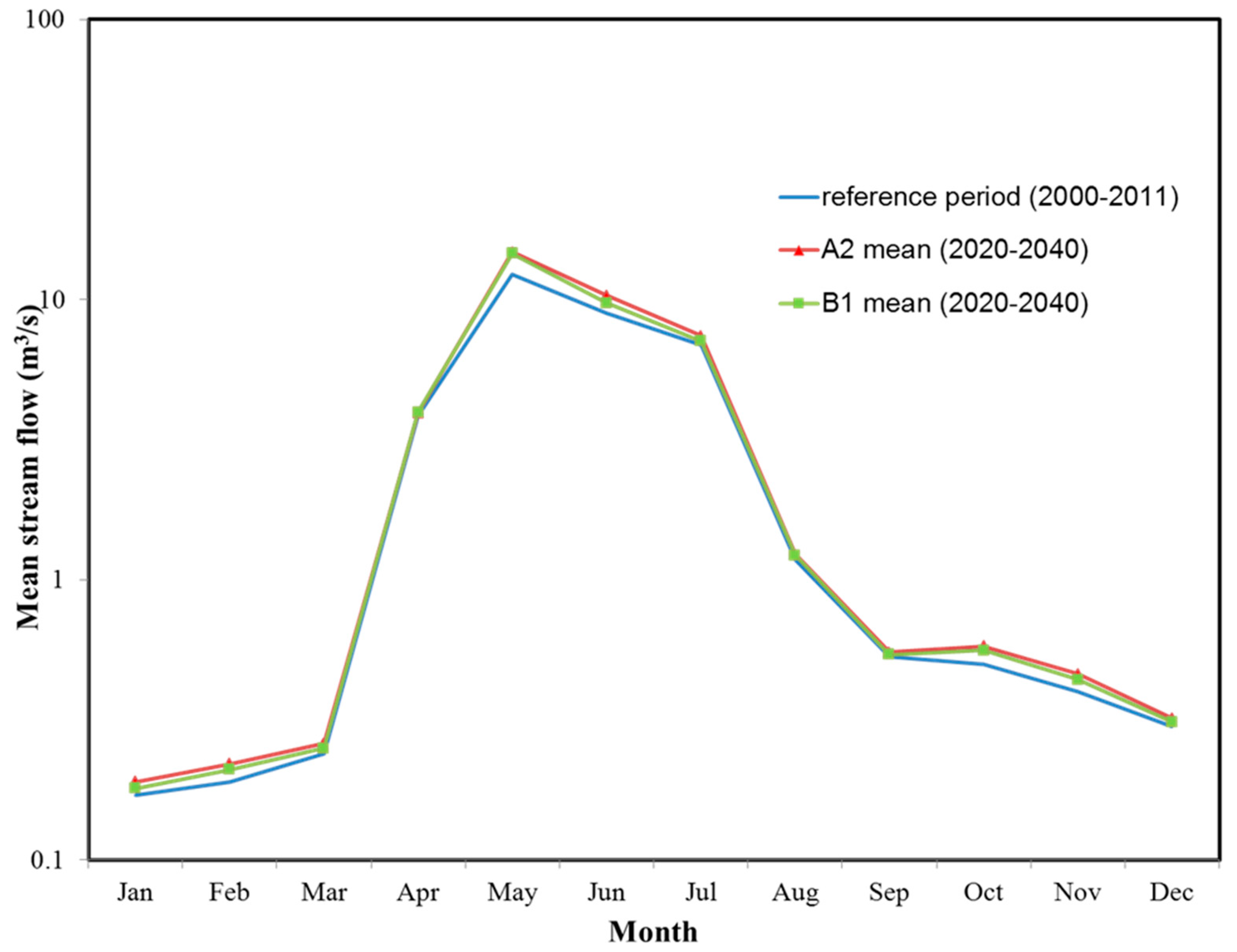
| Month | Stream Flow (m3/s) under Reference Period | Stream Flow (m3/s) under A2 Scenario | Percent Change under A2 Scenario | Stream Flow (m3/s) under B1 Scenario | Percent Change under B1 Scenario |
|---|---|---|---|---|---|
| January | 0.17 | 0.19 | 11.7 | 0.18 | 5.5 |
| February | 0.19 | 0.22 | 15.8 | 0.21 | 9.5 |
| March | 0.24 | 0.26 | 8.3 | 0.25 | 4 |
| April | 3.85 | 3.93 | 2.1 | 3.97 | 3.1 |
| May | 12.28 | 14.78 | 20.3 | 14.58 | 15.8 |
| June | 8.97 | 10.35 | 15.3 | 9.73 | 7.8 |
| July | 6.9 | 7.43 | 7.6 | 7.2 | 4.1 |
| August | 1.18 | 1.23 | 4.2 | 1.22 | 3.2 |
| September | 0.53 | 0.55 | 3.8 | 0.54 | 1.9 |
| October | 0.5 | 0.58 | 16 | 0.56 | 10.7 |
| November | 0.4 | 0.46 | 15 | 0.44 | 9.1 |
| December | 0.3 | 0.32 | 6.7 | 0.31 | 3.3 |
| Scenario | Winter | Spring | Summer | Fall |
|---|---|---|---|---|
| Reference period | 0.22 | 5.46 | 5.68 | 0.48 |
| A2 | 0.24 | 6.32 | 6.34 | 0.53 |
| (10%) | (16%) | (11%) | (11%) | |
| B1 | 0.23 | 6.27 | 6.02 | 0.51 |
| (6%) | (15%) | (6%) | (8%) |
| Scenario | Mean Annual precipitation (mm) | Mean Annual Temperature (°C) | Mean Annual Stream Flow (m3/s) | Mean Annual Groundwater Discharge (m3/s) | Mean Annual Surface Runoff (m3/s) |
|---|---|---|---|---|---|
| Reference | 498 | 2.7 | 2.96 | 2.43 | 0.53 |
| A2 | 525 | 3.46 | 3.42 | 2.55 | 0.87 |
| (5.5%) | (0.76) | (15.5%) | (5%) | (64.1%) | |
| B1 | 516 | 3.27 | 3.32 | 2.51 | 0.81 |
| (3.5%) | (0.57) | (12.1%) | (3.3%) | (52.8%) |
4.3. Uncertainties Regarding the Results of Climate Change Effects on Water Resources
5. Conclusions
Acknowledgments
Author Contributions
Conflict of Interest
References
- National Aeronautics and Space Administration. Available online: http://atmospheres.gsfc.nasa.gov/climate/?section=135 (accessed on 22 November 2014).
- Van Roosmalen, L.; Christensen, B.S.B.; Sonnenborg, T.O. Regional differences in climate change impacts on groundwater and stream discharge in Denmark. Vadose Zone J. 2007, 6, 554–571. [Google Scholar]
- Dams, J.; Salvadore, E.; van Daele, T.; Ntegeka, V.; Willems, P.; Batelaan, O. Spatio-temporal impact of climate change on the groundwater system. Hydrol. Earth Syst. Sci. 2012, 16, 1517–1531. [Google Scholar] [CrossRef]
- Bibi, U.M.; Kauk, J.; Balzter, H. Spatial-temporal variation and prediction of rainfall in northeastern Nigeria. Climate 2014, 2, 206–222. [Google Scholar] [CrossRef]
- Cooley, K.R. Effects of CO2 induced climatic changes on snowpack and streamflow. Hydrol. Sci. J. 1990, 35, 511–522. [Google Scholar] [CrossRef]
- Meenu, R.; Rehnana, S.; Mujumdar, P.P. Assessment of hydrologic impacts of climate change in Tunga-Bhadra river Basin, India with HEC-HMS and SDSM. Hydrol. Process. 2013, 27, 1572–1589. [Google Scholar] [CrossRef]
- British Columbia Ministry of Forests and Range. Climate Change, Impacts, and Adaptation Scenarios: Climate Change and Forests and Range Management in British Columbia; Technical Report 045; British Columbia Ministry of Forests and Range: Victoria, BC, Canada, 2008. Available online: http://www.for.gov.bc.ca/hfd/pubs/Docs/Tr/Tr045.htm (accessed on 21 May 2013).
- Eldorado Weather. Available online: http://www.eldoradocountyweather.com/canada/climate2/Vancouver%20International%20Airport.html (accessed on 21 November 2014).
- McCarthy, J.J.; Canziani, O.F.; Leary, N.A.; Dokken, D.J.; White, K.S. Climate change 2001: Impacts, adaptation and vulnerability, intergovernmental panel on climate change. Int. J. Climatol. 2002, 22, 1285–1286. [Google Scholar] [CrossRef]
- Kundzewicz, Z.W.; Mata, L.J.; Arnell, N.W.; Doell, P.; Jimenez, B.; Miller, K.; Oki, T.; Sen, Z.; Shiklomanov, I. The implications of projected climate change for freshwater resources and their management. Hydrol. Sci. J. 2008, 53, 3–10. [Google Scholar] [CrossRef]
- Solomon, S.; Qin, D.; Manning, M.; Chen, Z.; Marquis, M.; Averyt, K.B.; Tignor, M.; Miller, H.L. Climate Change 2007: The Physical Science Basis, Contribution of Working Group I to the Fourth Assessment Report of the IPCC; Cambridge University Press: Cambridge, UK, 2007. [Google Scholar]
- Chillborne Environmental. BC’s Peace River Valley and Climate Change. Available online: http://www.ceaa.gc.ca/050/documents/p63919/98108E.pdf (accessed on 6 November 2014).
- Dobson Engineering Ltd.; Urban Systems Ltd. Kiskatinaw River Watershed Management Plan. Available online: http://www.dawsoncreek.ca/cityhall/departments/water/watershed/background-watershed-management-plans/ (accessed on 18 November 2014).
- Saha, G.C. Groundwater-Surface Water Interaction under the Effects of Climate and Land Use Changes. Ph.D. Thesis, University of Northern British Columbia, Prince George, BC, Canada, 2014. [Google Scholar]
- GeoBase. Available online: http://www.geobase.ca (accessed on 15 January 2014).
- Paul, S.S. Analysis of Land Use and Land Cover Change in Kiskatinaw River Watershed: A Remote Sensing, GIS & Modeling Approach. Master Thesis, University of Northern British Columbia, Prince George, BC, Canada, 2013. [Google Scholar]
- Downer, C.W. Identification and Modeling of Important Stream Flow Producing Processes in Watersheds. Ph.D. Thesis, University of Connecticut, Mansfield, CT, USA, 2002. [Google Scholar]
- Downer, C.W.; Ogden, F.L. GSSHA: A model for simulating diverse streamflow generating processes. J. Hydrol. Eng. 2004, 9, 161–174. [Google Scholar] [CrossRef]
- Downer, C.W.; Ogden, F.L. Prediction of runoff and soil moistures at the watershed scale: Effects of model complexity and parameter assignment. Water Resour. Res. 2004, 39. [Google Scholar] [CrossRef]
- Sharif, H.O.; Ogden, F.L.; Krajewski, W.F.; Xue, M. Statistical analysis of radar-rainfall error propagation. J. Hydrometeorol. 2004, 5, 199–212. [Google Scholar] [CrossRef]
- Sharif, H.O.; Yates, D.; Roberts, R.; Mueller, C. The use of an automated now-casting system to forecast flash floods in an urban watershed. J. Hydrometeorol. 2006, 7, 190–202. [Google Scholar] [CrossRef]
- Swain, N.; Christensen, S.; Latu, K.; Jones, N.; Nelson, E.; Williams, G. A geospatial relational data model for ingesting GSSHA computational models: A step toward two-dimensional hydrologic modeling in the cloud. World Environ. Water Resour. Congr. 2013, 201, 2716–2725. [Google Scholar]
- Ogden, F.L.; Saghafian, B. Green and ampt infiltration with redistribution. J. Irrig. Drain. Eng. 1997, 123, 386–393. [Google Scholar] [CrossRef]
- British Columbia Ministry of Environment. Available online: http://www.env.gov.bc.ca/wsd/data_searches/wrbc/ (accessed on 10 August 2014).
- McWhorter, D.B.; Sunada, D.K. Ground-Water Hydrology and Hydraulics; LLC.: Fort Collins, CO, USA, 1977. [Google Scholar]
- Solinst. Available online: http://www.solinst.com (accessed on 20 May 2014).
- Kala Groundwater Consulting Ltd. Groundwater Potential Evaluation Dawson Creek, British Columbia. Available online: http://www.dawsoncreek.ca/wordpress/wpcontent/uploads/watershed/2001DCk_Kala_GWPotential.pdf (accessed on 18 June 2014).
- Santhi, C.; Arnold, J.G.; Williams, J.R.; Dugas, W.A.; Srinivasan, R.; Hauck, L.M. Validation of the SWAT model on a large river basin with point and nonpoint sources. J. Am. Water Resour. Assoc. 2001, 37, 1169–1188. [Google Scholar] [CrossRef]
- Van Liew, M.W.; Arnold, J.G.; Garbrecht, J.D. Hydrologic simulation on agricultural watersheds: Choosing between two models. Trans. Am. Soc. Agric. Eng. 2003, 46, 1539–1551. [Google Scholar] [CrossRef]
- US EPA. Lecture#5: Hydrological Processes, Parameters and Calibration. BASINS 4 Lectures, Data Sets and Exercises; United States Environmental Protection Agency: Washington, DC, USA, 2007.
- IPCC. Emission Scenarios; IPCC Special Report; Cambridge University Press: Cambridge, UK, 2000; p. 570. [Google Scholar]
- British Columbia Ministry of Energy and Mines. The Status of Exploration and Development Activities in the Montney Play Region of Northern BC. Available online: http://www.offshore-oilandgas.gov.bc.ca/OG/oilandgas/petroleumgeology/UnconventionalGas/Documents/C%20Adams.pdf (accessed on 19 December 2013).
- Ashraf Vaghefi, S.; Mousave, S.J.; Abbaspour, K.C.; Srinivasan, R.; Yang, H. Analysis of the impact of climate change on water resources components, drought and wheat yield in semiarid regions: Karkheh River Basin in Iran. Hydrol. Process. 2014, 28, 2018–2032. [Google Scholar] [CrossRef]
- Roy, L.; Leconte, R.; Brissette, F.P.; Marche, C. The impact of climate change on seasonal floods of a southern Quebec River Basin. Hydrol. Process. 2001, 15, 3167–3179. [Google Scholar] [CrossRef]
- Yang, H.; Faramarzi, M.; Abbaspour, K.C. Assessing freshwater availability in Africa under the current and future climate with focus on drought and water scarcity. In Proceedings of the 20th International Congress on Modeling and Simulation, Adelaide, Australia, 1–6 December 2013.
- Hay, L.E.; Wilby, R.L.; Leavesley, G.H. A comparison of delta change and downscaled GCM scenarios for three mountainous basins in the United States. J. Am. Water Resour. Assoc. 2000, 36, 387–398. [Google Scholar] [CrossRef]
- Xu, C.Y.; Widen, E.; Halldin, S. Modeling hydrological consequences of climate change—Progress and challenges. Adv. Atmos. Sci. 2005, 22, 789–797. [Google Scholar] [CrossRef]
- Andreasson, J.; Bergström, S.; Carlsson, B.; Graham, L.P.; Lindström, G. Hydrological change—Climate change impact simulation for Sweden. J. Hum. Environ. 2004, 33, 228–234. [Google Scholar]
- Bergström, S.; Carlsson, B.; Gardelin, M.; Lindström, G.; Pettersson, A.; Rummukainen, M. Climate change impacts on runoff in Sweden—Assessments by global climate models, dynamical downscaling and hydrological modeling. Clim. Res. 2001, 16, 101–112. [Google Scholar] [CrossRef]
- Graham, L.P. Climate change effects on river flow to the Baltic Sea. J. Hum. Environ. 2004, 33, 235–241. [Google Scholar]
- Graham, L.P.; Andréasson, J.; Carlsson, B. Assessing climate change impacts on hydrology from an ensemble of regional climate models, model scales and linking methods—A case study on the Lule River basin. Clim. Change 2007, 81, 293–307. [Google Scholar] [CrossRef]
- Bergeron, G.; Laprise, L.; Caya, D. Formulation of the Mesoscale Compressible Community (MC2) Model; Internal Report from Cooperative Center for Research in Mesometeorology: Montréal, QC, Canada, 1994; p. 165. [Google Scholar]
- Scibek, J.; Allen, D.M. Modeled impacts of predicted climate change on recharge and groundwater levels. Water Resour. Res. 2006, 42. [Google Scholar] [CrossRef]
- Vansteenkiste, T.; Tavakoli, M.; Ntegeka, V.; Willems, P.; de Smedt, F.; Batelaan, O. Climate change impact on river flows and catchment hydrology: A comparison of two spatially distributed models. Hydrol. Process. 2012, 27, 3649–3662. [Google Scholar] [CrossRef]
- Nyenje, P.M.; Batelaan, O. Estimating the effects of climate change on groundwater recharge and baseflow in the upper Ssezibwa catchment, Uganda. Hydrol. Sci. J. 2009, 54, 713–726. [Google Scholar] [CrossRef]
- Li, L.; Xu, H.; Chen, X.; Simonovic, S.P. Streamflow forecast and reservoir operation performance assessment under climate change. Water Resour. Manag. 2010, 24, 83–104. [Google Scholar] [CrossRef]
- Van Roosmalen, L.; Christensen, J.H.; Butts, M.; Jensen, K.H.; Refsgaard, J.C. An intercomparison of regional climate model data for hydrological impact studies in Denmark. J. Hydrol. 2010, 380, 406–419. [Google Scholar] [CrossRef]
- Rutledge, A.T. Computer programs for describing the recession of ground-water discharge and for estimating mean ground-water recharge and discharge from streamflow data—Update. U.S. Geological Survey: Reston, VA, USA, 1998; p. 43. [Google Scholar]
- Downer, C.W.; Ogden, F.L. Gridded Surface Subsurface Hydrologic Analysis (GSSHA) User’s Manual; Coastal and Hydraulics Laboratory: Vicksburg, MS, USA, 2006; p. 207. [Google Scholar]
- IPCC. Climate Change 2007: The Physical Science Basis, Contribution of working Group I to the 4th assessment report (AR4) of the Intergovernmental Panel on Climate Change; Cambridge University Press: Cambridge, UK, 2007; p. 996. [Google Scholar]
- Hydro, B.C. Potential Impacts of Climate Change on BC Hydro’s Water Resources. Available online: https://www.bchydro.com/content/dam/hydro/medialib/internet/documents/about/climate_change_report_2012.pdf (accesses on 15 January 2015).
- Vivoni, E.R.; Entekhabi, D.; Bras, R.L.; Ivanov, V.Y. Controls on runoff generation and scale-dependence in a distributed hydrologic model. Hydrol. Earth Syst. Sci. 2007, 11, 1683–1701. [Google Scholar] [CrossRef]
- Price, K.; Leigh, D.S. Morphological and sedimentological responses of streams to human impact in the southern Blue Ridge Mountains, USA. Geomorphology 2006, 78, 142–160. [Google Scholar] [CrossRef]
- Leigh, D.S. Hydraulic geometry and channel evolution of small streams in the Blue Ridge of western North Carolina. Southeast. Geogr. 2010, 50, 394–421. [Google Scholar]
- Ontario Ministry of Agriculture, Food and Rural Affairs. Soil Erosion—Causes and Effects 2012. Available online: http://www.omafra.gov.on.ca/english/engineer/facts/12–053.pdf (accessed on 12 January 2015).
- Christensen, J.H.; Christensen, O.B. A summary of the PRUDENCE model projections of changes in European climate by the end of this century. Clim. Change 2007, 81, 7–30. [Google Scholar] [CrossRef]
© 2015 by the authors; licensee MDPI, Basel, Switzerland. This article is an open access article distributed under the terms and conditions of the Creative Commons Attribution license (http://creativecommons.org/licenses/by/4.0/).
Share and Cite
Saha, G.C. Climate Change Induced Precipitation Effects on Water Resources in the Peace Region of British Columbia, Canada. Climate 2015, 3, 264-282. https://doi.org/10.3390/cli3020264
Saha GC. Climate Change Induced Precipitation Effects on Water Resources in the Peace Region of British Columbia, Canada. Climate. 2015; 3(2):264-282. https://doi.org/10.3390/cli3020264
Chicago/Turabian StyleSaha, Gopal Chandra. 2015. "Climate Change Induced Precipitation Effects on Water Resources in the Peace Region of British Columbia, Canada" Climate 3, no. 2: 264-282. https://doi.org/10.3390/cli3020264
APA StyleSaha, G. C. (2015). Climate Change Induced Precipitation Effects on Water Resources in the Peace Region of British Columbia, Canada. Climate, 3(2), 264-282. https://doi.org/10.3390/cli3020264





